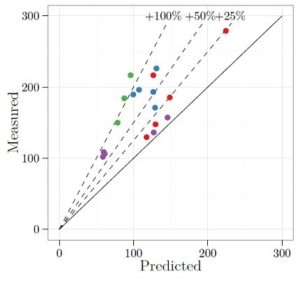Subtask 3 of the IEA EBC Annex 71
Current strategies to reduce the operating energy consumption of the built environment are underpinned by the assumption that a building in-situ exhibits the same performance characteristics as that which were defined in the theoretical design stage. The challenge of this assumption has led to the growth of a body of evidence suggesting that there exists a performance gap between building design and completion. In order to evaluate this performance gap, it is necessary to empirically evaluate the physical parameters of the completed building, permitting direct comparison with the theoretical design targets. Typically this is an intrusive and lengthy process, requiring invasive tests to be undertaken whilst the building is unoccupied.
In response to the existing constraints associated with physical parameter identification of in situ buildings, Subtask 3 of the IEA EBC Annex 71 aims to develop analysis methods that may be applied to limited datasets gathered from occupied buildings using unobtrusive equipment such as smart meters. Subtask 3 will build on the knowledge and learning generated during Subtask 2 (building behaviour identification), but rather than attempt to quantify building behaviour for application in other scenarios, Subtask 3 aims to quantify the physical parameters such as the heat transfer coefficient, net energy demand, air tightness and heating/cooling system efficiency. The work will be evaluated against standards and the work will normalise estimated in-use energy use with national standards.
Case studies centred on in-use data from buildings with known physical parameters will form the basis of model development, with multiple approaches ranging from linear regression to grey-box modelling to be explored. Critical to the development of the numerical models will be an appreciation of the uncertainties associated with each method, and as such confidence intervals and quality assessment will be central in Subtask 3. Initial models will utilise all available in-use data, however once sufficiently robust methods for building parameter identification have been generated, stepwise reduction of input data will be undertaken to investigate the minimum data requirement for reliable results.
Subtask 3 will investigate whether in-use data is sufficient to allow the development of robust methods to establish the physical parameters of a building in-situ, and determine the confidence with which these models may be applied. Additionally, the minimum amount of input data required for model development will be explored, and the impact that lower quality data has on model success recognised. The output from Subtask 3 will feed directly into Subtask 4, seeking to apply the findings in a real world context for quality assessment.
The work of this and related subtasks will develop non-intrusive methods of extracting reliable data on building’s characteristics and behaviour. As buildings start to incorporate monitoring systems, recording real life data, appropriate disaggregation and analysis techniques are required to underpin and support building automation systems. Understanding the metrics, standards and appropriate use of the data is essential if the industry is to make effective use of smart meters, home automation systems and wireless technologies. The work of Annex 71 will provide a knowledge base and more robust metrics and methods on which the industry can build.
Chris Gorse, Leeds Beckett University

